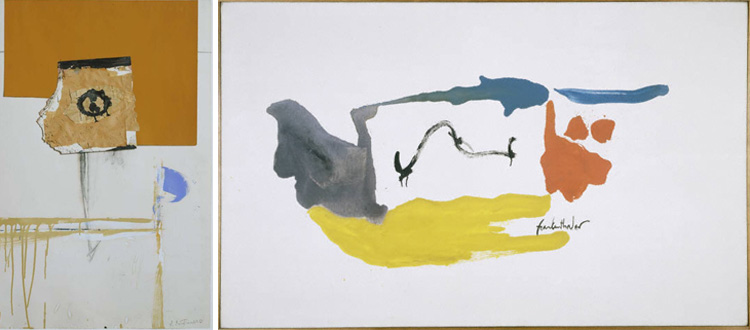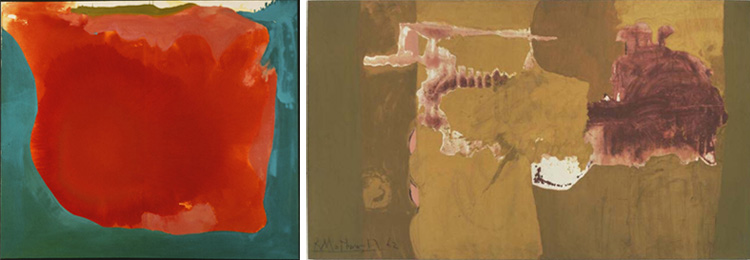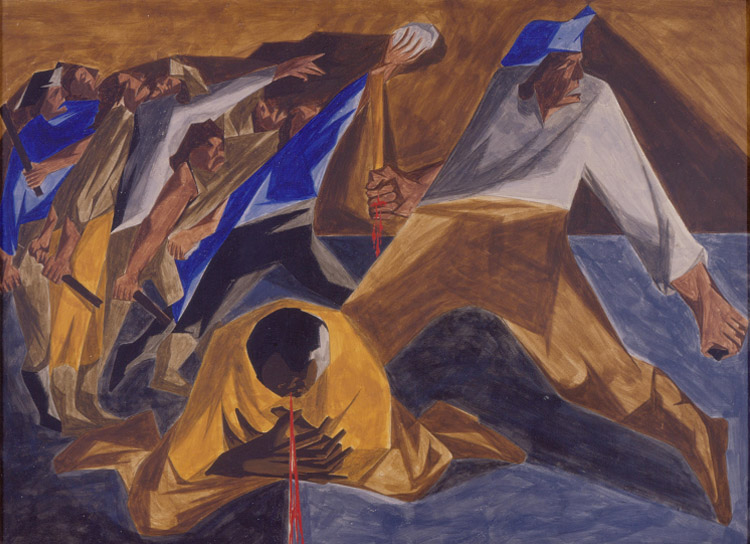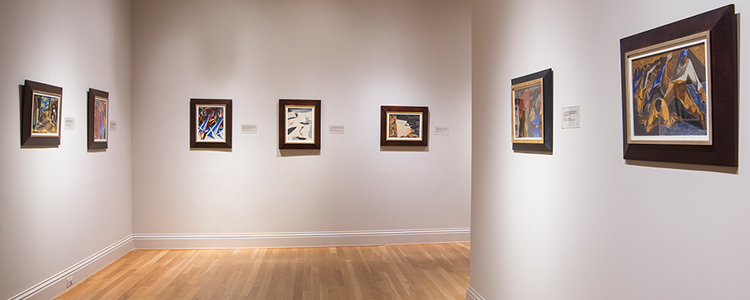
(left) Robert Motherwell, In White and Yellow Ochre, 1961. Oil, charcoal, ink, tempera and paper collage on paper, 40 7/8 x 27 in. The Phillips Collection, Washington, DC, acquired 1965. Art © Dedalus Foundation, Inc./Licensed by VAGA, New York, NY (right) Helen Frankenthaler, Runningscape, 1962. Oil on canvas, 32 in x 52 in. The Phillips Collection, Washington, DC, Gift of Gifford and Joann Phillips, 2009; © 2012 Artists Rights Society (ARS), New York
Two of the Phillips’s most cherished Abstract Expressionist artists, Helen Frankenthaler and Robert Motherwell, shared more than a style of painting: they were also married from 1958 to 1971. Currently, a group of the couple’s works from the museum’s permanent collection are on display in neighboring galleries. Four of my favorites are Canyon and Runningscape, both by Frankenthaler, and In White and Yellow Ochre and Chi Ama, Crede by Motherwell.
Studying these works in a group, I began to think of the differences in the two artists’ styles, despite the fact that all four of the works were created in the early 1960s. I compared the soft applications of oil and acrylic in both of Frankenthaler’s works to the more aggressive elements in Motherwell’s. Utilizing varied textures, Motherwell’s In White and Yellow Ochre combines mediums with collaged materials, resulting in a harsher design and abstracted contours. In contrast, Frankenthaler uses oil paint like watercolor in Runningscape, thinning it into washes that bleed into each other to create a fluid design. Each of the artists’ larger pieces—Frankenthaler’s Canyon and Motherwell’s Chi Ama, Crede—also contain these distinctions, Canyon being composed of expansive fields of saturated color and Chi Ama, Crede of jagged applications in dull maroons and browns.

(left) Helen Frankenthaler, Canyon, 1965. Acrylic on canvas, 46 1/8 in x 52 3/4 in. The Phillips Collection, Washington, DC, The Dreier Fund for Acquisitions and funds given by Gifford Phillips, 2001; © 2012 Artists Rights Society (ARS), New York (right) Robert Motherwell, Chi Ama, Crede, 1962. Oil on canvas, 82 x 141 in. The Phillips Collection, Washington, DC, The Whitehead Foundation, Mr. and Mrs. Laughlin Phillips, Mr. and Mrs. Marc E. Leland, and the Honorable Ann Winkelman Brown and Donald A. Brown, 1998; Art © Dedalus Foundation, Inc./Licensed by VAGA, New York, NY
What is interesting is that both artists were influenced by the same group of contemporaries: Abstract Expressionists such as Jackson Pollock, Willem de Kooning, and Mark Rothko. They also created these works in the early years of their marriage, when they were likely collaborating and comparing painting techniques. Their differences are thus results of their own personal styles retained throughout their independent careers. Frankenthaler’s paintings are distinctly feminine, whereas Motherwell’s works have a more aggressive appearance of masculinity. This pair of artists serve as a unique look at the female and male perspectives on a specific movement of art.
Annie Dolan, Marketing and Communications Intern


